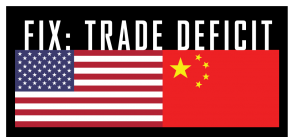- 46 reads

This report caught the eye of our GREENandSAVE editorial team, because the latest LED technology has the ability to reduce energy consumption and in turn reduce CO2 emissions from burning fossil fuels at power plants. If your company or association would like to submit one of your reports for our review, please Contact Us and we will review it for publication to our readership.
IMPACT REPORT 2018
China Trade Deficit Reduction Through Trump's Buy American and Hire American Executive Order
Report Date: 06.14.18.
Over these past few months, the Trump Administration has learned that negotiating with the Chinese to reduce the $375 billion U.S. trade deficit is more complicated than they may have expected. In 2017, our exports to China were only $130 billion while imports from China were over $505 billion. The complexity of tariffs and national interdependence have reduced clarity along lines of winners and losers. Last year, on April 18, 2017, President Trump signed the “Buy American and Hire American” Executive Order, and many U.S. manufacturers saw this as a win for their businesses and the American economy. The intent of the Executive Order was to create more U.S. jobs in manufacturing by directing U.S. federal agencies to purchase American made products over imports. With more than 3 billion square feet of federal real estate and annual spending of over $4 trillion, the U.S. government has massive buying power. The Executive Order calls for purchasing U.S. goods in accordance with prior trade agreements, but the strategy is more clear than the execution to date.
The complexity of government procurement is compounded with the difference in the Buy American Act (BAA) and the Trade Agreements Act (TAA). BAA calls for products with over 50% domestic U.S. components while TAA accepts products with a majority of components that are made in trade partner countries such as Canada, Mexico, and now Taiwan. To meet the Executive Order’s job creation goal, the Trump Administration should encourage BAA Compliance to maximize economic impact. Annual reporting to the public would also provide clarity into the levels of adherence by the agencies.
A manufacturing job ripple effect will come with BAA Compliance. In many cases, jobs are created beyond those inside factories through the supply chain of cardboard box production to installation. The breadth of blue-collar and white-collar jobs is extensive, especially in the latest clean-technology sectors such as energy-efficient lighting, solar, and wind power. Added domestic employment for engineering, intellectual property, account management, and software development are part of the Science, Technology, Engineering, and Math (STEM) family of jobs related to 21st century manufacturing.
The U.S. government can take a bite out of the China trade deficit through daily small purchases as well as large procurements. As an example, across the 3.4 billion square feet of federal real estate, the government may have up to 90 million fluorescent tubes in the ceilings. Fluorescent tubes are almost all made in China and cost about $2 each. This adds up to $180 million in spending, and each tube lasts about 5 years. Each year the government may be spending $36 million on Chinese tubes. This translates to about $100,000 per day that the government is spending to replace old Chinese products with new Chinese products. This is just for lights, and it is in direct breach of Trump’s Buy American and Hire American Executive Order. For context, the U.S. government spends about $600 million per year on office supplies, which is over $1.5 million per day, and it is not clear what percentage of those products are manufactured in America.
As the Chairman of the Leadership Council for the American LED Alliance, and the CEO of Independence LED Lighting, I know what it takes to make lights vs staplers or big ticket items like fighter jets. We moved our light emitting diode (LED) fixture manufacturing from China to southeastern Pennsylvania in 2010, and Independence LED became one of the first Buy American Act (BAA) Compliant LED fixture manufacturers. Adhering to the Executive Order for lighting will not make much of a dent in the $375 billion trade deficit with China, but changing to efficient LED lights will save 50% or more on energy consumption for tax payers and create tens of thousands of jobs along the way.
Manufacturing jobs in the U.S. are at a current trough relative to World War II and 20th century levels. Jobs peaked at 19.4 million in 1979 for U.S. manufacturing and are now at 12.5 million, which is 8.5 percent of the 147 million U.S. workforce. The new tax landscape has created a more level playing field, so more U.S. manufacturers may bring more jobs back to the U.S.
The Trump Administration can lead by example when it comes to purchasing American made products. The Executive Order set the foundation, but a solid roll-out requires more rigor and reporting from the agencies. The American people deserve to know how their money is spent, and President Trump can ask each agency to report on the percentage of imported vs domestic product purchases. This sets a benchmark, and measurement is the key to management. Establishing a time frame and a goal to increase domestic acquisition levels lets tax payers know the plan. Visibility also lets current manufacturers and entrepreneurs identify opportunities to participate in the mega-machine of U.S. government procurement and eat away at the China trade deficit one bite at a time.
By Charlie Szoradi, CEO of Independence LED Lighting & Chairman of the Leadership Council for the American LED Alliance
Click here for the comprehensive Report Research Source Information.

